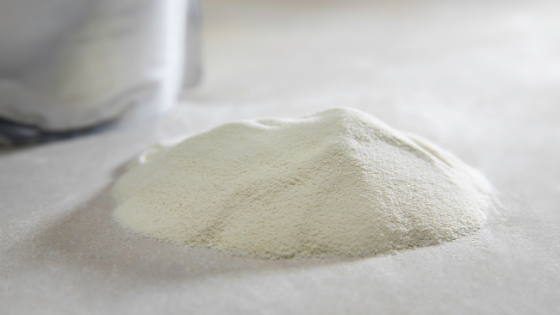
Whey proteins, clean label ingredients
Whey is a co-product of cheese production and is rich in proteins. It can be processed in the form of protein powder which is used in sports or clinical nutrition, for example. These proteins are well known for enriching products and, increasingly, for their functional properties. Below we explain the opportunity that whey proteins represent in the formulation clean label products.
What is a clean label?
Consumer needs
Clean label encompasses many concepts:
-
-
- Simple and well-known ingredients
- GM-free
- No preservatives,
- A short list of ingredients
- Simple manufacturing processes
- Low-processed products
-
We are witnessing a real quest for meaning in consumer choices. The clean label trend meets the consumer’s need for naturalness, health, authenticity, and transparency. Consumer expectations are becoming increasingly high:
-
-
- “Made with real ingredients” and “no artificial colors or flavors” are the most sought-after claims in China.[1]
- Claims advocating “additive-free” naturalness and “locally produced” ethics are sought by 69% and 67% of Americans, respectively.[2]
- 69% of European consumers find that there are too many artificial ingredients[3] in sports nutrition products.
-
The clean label trend meets the consumer’s need for naturalness, health, authenticity, and transparency.
However, there is no official regulatory definition of a clean label. Moreover, there is a certain amount of legislative vagueness on this subject. The term could be associated with claims such as “no additives”, or “no artificial flavors”. In view of consumer expectations and the stakes involved, the clean label concerns all stakeholders in the agri-food industry, including the dairy sector.
A challenge for the dairy sector
Apart from among sports enthusiasts and top athletes, whey proteins were little known to consumers. Today they have come to the forefront with the development of sports nutrition, clinical nutrition and the dynamics of healthy aging. But more than ever, they are meeting the challenges of naturalness and authenticity.
The dairy sector has every interest in meeting these expectations in the creation of recipes. In terms of pleasure thanks to appreciated organoleptic qualities. In terms of sourcing with transparent raw materials. In terms of the choice of clean label ingredients, reassuring the consumer.
The dairy sector has every interest in meeting these expectations in the creation of recipes.

How do whey proteins fit into the clean label trend?
A protein powder made from a traditional raw material known to the consumer: milk.
Whey protein is derived from a local and traceable agricultural raw material: whey, a co-product of cheese production. Using this whey protein for nutritional and organoleptic purposes is therefore a way of upcycling these proteins and making them useful in the food industry. Finally, the dairy sector, from which the proteins are derived, meets certain production requirements such as animal welfare, GMO-free food, or products from organic farming. The latter reassure consumers in full transparency and authenticity as regards the origin of the product.
Organoleptic qualities for the pleasure of consumers
Whey proteins can be used in different types of products such as drinks, yoghurts, food supplements, infant milks, etc. In addition to this versatility, research is also focusing on the replacement of more controversial ingredients such as:
-
-
- Thickeners (modified starch)
- Gelling agents (gelatin)
- Emulsifiers (E471)
-
Whey proteins have many functional uses: as gelling agents, texturing agents, emulsifiers, or foaming agents. Thus, as versatile products and through the contribution of their functional or nutritional properties, they are particularly adapted to the agri-food industry.
Whey proteins have many functional uses: as gelling agents, texturing agents, emulsifiers, or foaming agents.
Our clean label proteins
Lactalis Ingredients offers you a range of clean-label whey proteins. While each is specific, they also have points in common, in particular a high protein and a low fat content. Finally, they have a neutral taste, which is ideal for facilitating their use in different recipes or applications.
Laktein WPC 80 / WPI
This highly functional protein of French origin is characterized by its high quality and abundant properties. It can be used as a substitute for eggs or as a texturing agent for yoghurts. It is the ideal ingredient for “clean label” products.
Pronativ®
As a native whey protein, Pronativ® is obtained directly from milk. Thanks to a cold filtration method, minimal treatment and no chemicals or additives, it is fully aligned with a clean label approach. It is characterized by a high protein content (up to 95% on dry matter). Thanks to its high leucine content, it allows better protein absorption and is therefore a high-quality protein source. It can be used in ice cream, yoghurt, or protein-enriched drinks.
To conclude, whey proteins are clean label proteins, in line with the new challenges of the food transition. They make it possible to meet the nutritional and functional challenges of product reformulation. Ultimately, the aim is to meet consumer expectations in terms of naturalness and transparency.
Sources :
[1] Lindberg International, Organic Foods – Customer Insights Chine, 2019
[2] Lek, Consumers’ favourite claims, 2018
[3] Mintel, Food Ingredients Europe, 2019















